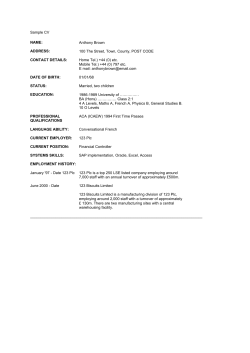
Monday 13 October 2014 Season of mists
Monday 13 October 2014 Season of mists Investors who have become accustomed to stable and rising equity markets in recent times might have become concerned about the increased volatility over the last few days. However, the latest bout of uncertainty serves as a timely reminder that this is how markets typically behave. Recent months have been marked by historically low levels of volatility and, for some time, investors have anticipated that a return to more normal conditions was likely as the world adjusts to the postQE era in the US and the prospect of interest rate rises in those economies on the recovery trail. But just as investors should not get overly optimistic in times of rising markets, nor should they overreact or become unduly pessimistic when markets are more volatile. It is also notably the case that, whether by coincidence or otherwise, October has a reputation as a time of turbulence for the global markets. Some of the dramatic declines in financial history, from the Great Crash of 1927, to Black Monday in 1987 and the start of the US bear market in 2007, have occurred as autumn gathers pace. Equally though, October also emerges as the third best-performing month of the year, behind December and April, according to US investment research group Morningstar. The history of the US benchmark S&P 500 index for the month is littered with strong performances, including monthly returns in 1998 of 8%, 9% in 2002 and 11% in 2011. Headwinds and tailwinds Global markets closed on Friday after an uncertain week amid concerns over the outlook for world economic growth, geopolitical risks and central bank policies. Stock market indices in London and Frankfurt hit their lowest point this year. US stocks fell to their lowest levels since late May, with the S&P 500 index down 3.1% over the week to 1,906 points; which was 5.6% down from a record closing high struck in mid-September. The US equity benchmark had its worst day since April on Thursday with a fall of 2.1%, which followed its biggest one-day gain for a year with an advance of 1.75% on Wednesday. The MSCI World index fell 3% over the week to hit its lowest level since February amid an exit from riskier assets for the perceived safety of government bonds and other ‘haven’ assets. The Chicago Board Options Exchange’s VIX index, known as the ‘fear gauge’, was up 13.2% on Friday to 21.2 points – a level not reached since the end of 2012. However, the backdrop for the market unease has been a range of geopolitical threats which are nothing new – from ebola to war in the Middle East and Ukraine – together with weak data from Germany and China. What changed last week was the sentiment surrounding these issues. Just as easily, that sentiment can change again; at the time of writing, markets across Europe have stabilised in morning trading. However, whilst there are no grounds for complacency, fears that these conditions will presage a crash seem overdone. Despite gloomy soundings from the International Monetary Fund (IMF), the world economy continues its slow recovery led by the US and assisted by loose monetary policy (which is ending with the goals of US growth and strong asset prices achieved). There could be a new phase for the post-2009 US bull run; but corrections are part of market cycles, and offer opportunities to long-term investors. It is worth noting too that investors who have stuck with the S&P 500 index since March 2009 would have enjoyed returns of 178%. The strength and confidence of the US economy does not look like the usual ground for a bear market. Instead, the growth trajectory for the world’s largest economy has gathered momentum. Recent US data shows that the economy continues to expand and employers are adding more jobs, which will increase demand. Wall Street this week expects retail sales figures to be up by 0.4% in September from a month earlier, homebuilder confidence figures to remain at a nine-year high and the number of new homes to rise by 5%. Meanwhile, the US Federal Reserve hinted that it would consider prolonging accommodative policy a little longer amid the sluggish growth outside the US (including the UK). In New York, mid-October marks the start of the third-quarter earnings season and there are concerns that the strength of the dollar could hamper the quarterly figures for US exporters; however, it could also dampen import costs and make it easier for the Fed to hold interest rates, which would be good for share prices. The US technology sector took a dent last week as investors moved into more defensive areas, including utilities. Energy stocks tumbled as global oil prices came under pressure. Amidst such uncertainty, trying to second-guess the next move for equities from high-level macro events is something we have always cautioned against. Squall shelter As markets wobbled, nervous global investors moved to the shelter of other assets, including the US dollar and longerdated US Treasuries. The 10-year bond yield declined 2 basis points to 2.29%, after it had hit its lowest level since mid2013. Brent oil ended the week at $90 a barrel, after reaching its lowest level since December 2010 of $88 a barrel. Bank of America Merrill Lynch reported a dash for cash among investors, with the flight of $47 billion into money market funds in the week to 8 October; meanwhile, $16 billion flowed into bond funds and $13 billion into equity funds. Falling oil prices have also raised concern among investors, fuelling speculation of an impending global downturn. Again, this nervous interpretation seems over-dramatic. The decline in commodity prices reflects increased supply and the strength of the dollar, rather than a slump in demand. (Oil markets historically are one of the commodities least correlated with changes in global growth.) Despite the downbeat picture from the International Monetary Fund, the shop-floor data provided by Markit – which offer a more immediate snapshot – suggests that global growth rose in the third quarter to 3.5–4% from 2.8% in the second quarter. The IMF signalled last week that Europe risked a Japan-style lost decade unless the eurozone could kick-start economic activity, and move to full-blown quantitative easing (QE). Mario Draghi, president of the European Central Bank, insisted that monetary policy alone was not sufficient to restore growth. Wolfgang Schäuble, the German finance minister, called for structural reform in France and Italy. Meanwhile, German economic data for production, factory orders and exports continued to disappoint. Frankfurt’s DAX index lost 4% last week to close at 9,196 points; Paris’s CAC 40 index fell to its lowest level this year. The German 10-year government bond yield ended the week at 0.89%, down 4bp on the week. In Tokyo, the Nikkei 225 Stock Average fell by 2.6% over the five-day period to 15,301 points, which was its lowest point for two months, as the Bank of Japan last week indicated that it would not increase stimulus levels for the country’s moribund economy. Despite this, Hugh Young of Aberdeen Asset Management Asia believes that valuations in Japan and the wider region remain supportive and that investors can be rewarded over the long term through prudent selection of stocks. “We are seeing better capital management and more share buybacks, in line with Prime Minister Shinzo Abe’s push to raise governance standards and enhance shareholder returns,” adds Young. Autumn chill The October gusts through the world financial centres have put a chill in the air for investors, but, from a long-term perspective, only serve to emphasise the importance of maintaining a diversified investment approach. Cash remains an important element in that strategy. The elevated cash weightings in a number of fund managers’ portfolios provides them with the vital liquidity to put the money to work when valuation opportunities, such as this latest dip, present themselves. Equally, other asset classes continue to have their place. Fund manager Threadneedle’s head of fixed income, Jim Cielinski, notes that corporate bonds have reasonable yield premiums, even if government bond yields are relatively low. Commercial property with yields of 5–6% is another attractive income proposition, says Orchard Street partner John Humberstone. But investors are still drawn to equities in this transition phase for interest rates. In these conditions, global equities continue to look attractive, despite concerns about valuations. Aberdeen Asset Management, Orchard Street and Threadneedle are fund managers for St. James’s Place. The ‘St. James’s Place Partnership’ and the titles ‘Partner’ and ‘Partner Practice’ are marketing terms used to describe St. James’s Place representatives. Members of the St. James’s Place Partnership represent St. James’s Place Wealth Management plc, which is authorised and regulated by the Financial Conduct Authority. St. James’s Place Wealth Management plc, St. James’s Place UK plc, St. James’s Place Unit Trust Group Ltd and St. James’s Place International plc are members of the St. James’s Place Wealth Management Group. St. James’s Place UK plc is authorised by the Prudential Regulation Authority and regulated by the Financial Conduct Authority and the Prudential Regulation Authority. St. James’s Place Unit Trust Group Ltd is authorised and regulated by the Financial Conduct Authority. St. James’s Place International plc is authorised and regulated by the Central Bank of Ireland. St. James’s Place Wealth Management plc Registered Office: St. James’s Place House, 1 Tetbury Road, Cirencester, Gloucestershire, GL7 1FP, United Kingdom. Registered in England Number 4113955.
© Copyright 2025





















